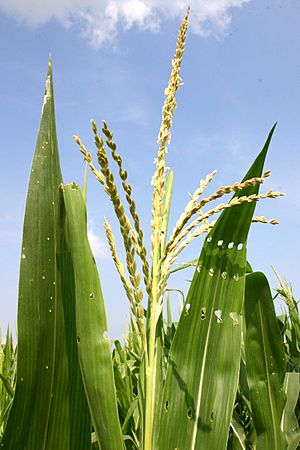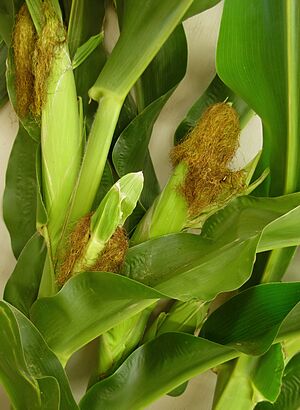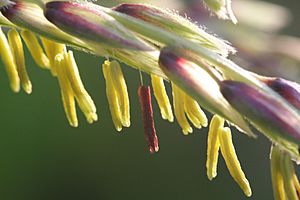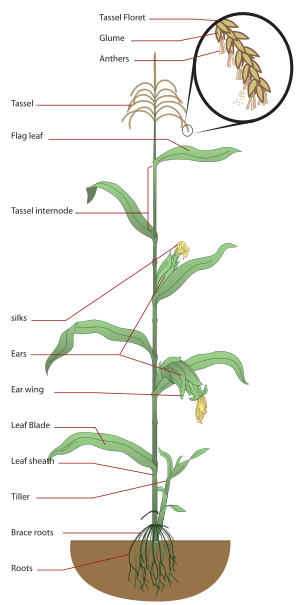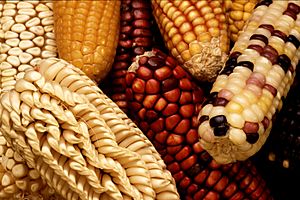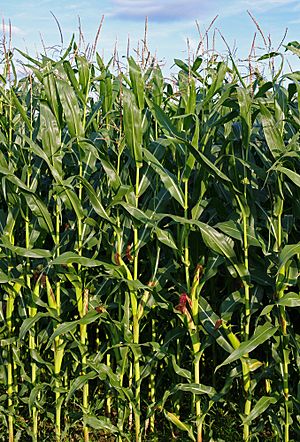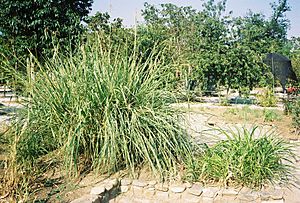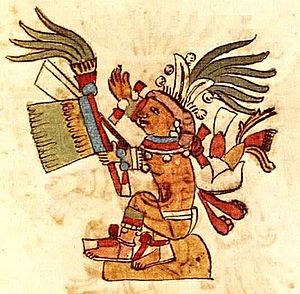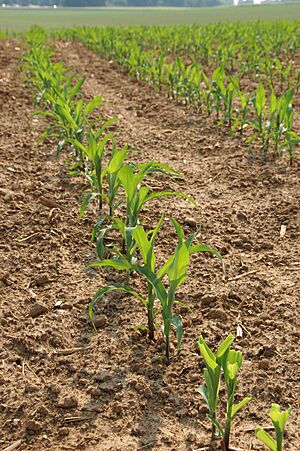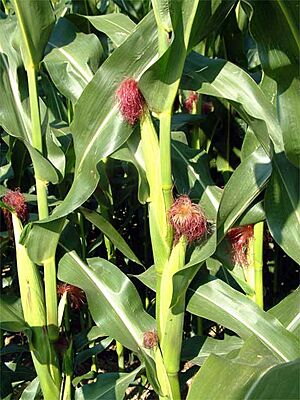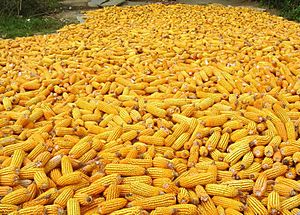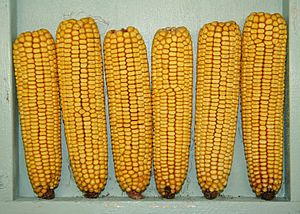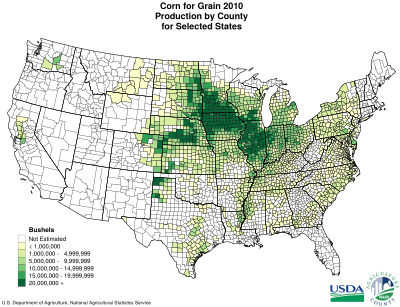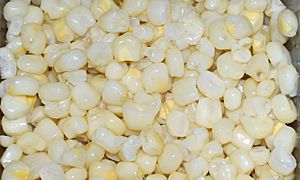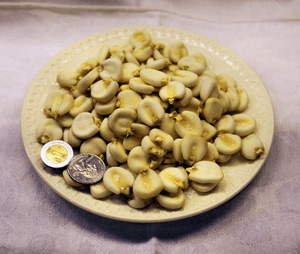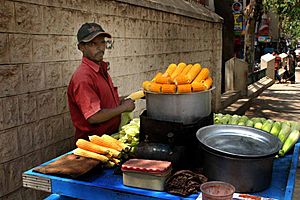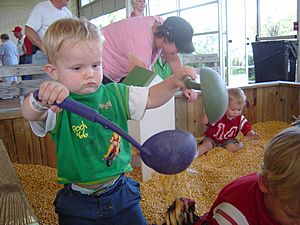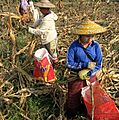Maize facts for kids
Quick facts for kids Maize |
|
|---|---|
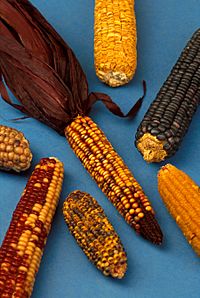 |
|
| Cultivars of maize | |
| Scientific classification | |
| Kingdom: | |
| Division: | |
| Class: | |
| Order: | |
| Family: | |
| Subfamily: |
Panicoideae
|
| Tribe: |
Andropogoneae
|
| Genus: |
Zea
|
| Binomial name | |
| Zea mays |
|
Maize (often called corn in some countries) is a type of grass called Zea mays. It belongs to the grass family Poaceae. This cereal grain was first grown by people in ancient Central America. Today, it is the third most important cereal crop in the world.
Maize has a leafy stalk with seeds inside its kernels. It is a flowering plant, meaning its seeds are covered by a fruit or shell. Many people in Mexico, Central and South America, and parts of Africa eat maize as a main food. In Europe and the rest of North America, maize is mostly grown to feed animals. In Canada and the United States, maize is usually called "corn." Recently, corn starch has become a key part of many American foods.
Maize has been very useful for genetics research for many years. Scientists like Barbara McClintock studied it. Research shows that maize was developed from a Mexican plant called Teosinte through selective breeding.
Contents
What Do We Call Maize?
The word "maize" comes from the Spanish word maiz, which came from the Taíno people's word for the plant. It has other names around the world.
Outside the United States, "corn" can mean any cereal crop. Its meaning changes depending on the area. It usually refers to the main local food. In the United States, "corn" mostly means maize. This started as a shorter way to say "Indian corn." "Indian corn" usually means maize, which was the main grain for Native Americans. It can also mean colorful "flint corn" used for decoration.
Outside the U.S., "corn" often refers to maize when talking about food. More specific names are used to be clear, like "sweet corn" or "corn on the cob." Other examples include "popcorn" and "corn flakes."
In Southern Africa, maize is commonly called "mielie" or "mealie."
"Maize" is preferred in science and formal settings. This is because it refers only to this one grain. "Corn" has many meanings that change with where you are and how you use it. However, in large-scale trading, people use "corn" only for maize. Organizations like the FAO and CSIRO use "maize." Many farming groups also use "maize" in their names. This is true even in English-speaking countries where people might use a different word.
How Maize Grows
Maize stems look a bit like bamboo. The sections between the leaves can be about 7 inches long. Maize grows in a special way. Its lower leaves are wide, usually 2 to 4 feet long and 2 to 4 inches wide. The stems stand straight up, usually 7 to 10 feet tall. They have many nodes, where flag-leaves grow. The ears of corn grow under these leaves, close to the stem. They grow about 3 millimeters each day.
The ears are the female parts of the plant. They are tightly covered by several layers of leaves. You can't easily see them until the pale yellow silks appear from the end of the ear. The silks are long, thin stigmas that look like tufts of hair. They are green at first, then turn red or yellow. Farmers can grow maize plants very close together for silage. This makes more plant matter but fewer ears. Some types of maize are grown to produce many ears. These are used for "baby corn" in Asian cuisine.
Maize is a plant that flowers after a certain number of warm days. This is true for the environment it is used to. If tropical maize grows in places with very long days, it might grow too tall. Then it might not have enough time to make seeds before frost kills it. But these tall plants could be useful for making biofuel.
The very top of the stem has a "tassel." This is where the male flowers are. When the tassel is ready and the weather is warm and dry, it releases pollen. Wind carries maize pollen. Most of it falls within a few meters of the tassel. Each silk can be pollinated to make one kernel of maize. Young ears can be eaten raw, with the cob and silk. But as the plant gets older (usually in summer), the cob gets tougher. The silk also dries out and cannot be eaten. By the end of the growing season, the kernels dry out. They become hard to chew without cooking them in boiling water first. Modern farming often plants maize close together. This usually makes one large ear per stalk.
Maize Kernels
A maize kernel has its fruit wall joined with its seed coat. This is called a "caryopsis," which is common for grasses. The whole kernel is often called a "seed." The cob is like a multiple fruit, but the individual fruits (kernels) do not join into one mass. The grains are about the size of peas. They stick together in neat rows around a white, soft center that forms the ear. An ear can usually hold 600 kernels and be 7 inches long. They come in many colors: black, bluish-gray, purple, green, red, white, and yellow. When ground into flour, maize makes more flour with less bran than wheat. It does not have the protein gluten like wheat. So, baked goods made with maize flour do not rise well.
A special type of maize that has more sugar and less starch in the ear is eaten as a vegetable. It is called sweet corn.
Young maize plants have a strong substance called DIMBOA. This helps protect them from many pests, like insects, harmful fungi, and bacteria. DIMBOA is also found in other grasses, like wheat. If a maize plant does not have DIMBOA, it is easily attacked by aphids and fungi. DIMBOA also helps young maize resist the European corn borer. As maize gets older, DIMBOA levels drop, and it becomes less resistant to the corn borer.
Maize has shallow roots. This means it can be hurt by dry weather. It also does not like soils without enough nutrients. Strong winds can easily pull it out of the ground.
Maize Genetics
Many types of maize are used for food. They are sometimes grouped by how much starch they have:
- Flour corn — Zea mays var. amylacea
- Popcorn — Zea mays var. everta
- Dent corn — Zea mays var. indentata
- Flint corn — Zea mays var. indurata
- Sweet corn — Zea mays var. saccharata and Zea mays var. rugosa
- Waxy corn — Zea mays var. ceratina
- Amylomaize — Zea mays
- Pod corn — Zea mays var. tunicata Larrañaga ex A. St. Hil.
- Striped maize — Zea mays var. japonica
Maize has 10 chromosomes. The total length of these chromosomes is 1500 cM. Some maize chromosomes have "chromosomal knobs." These are parts that stain darkly and have many repeated DNA sections. These knobs can be different among various types of maize and teosinte.
Barbara McClintock used these knob markers to prove her idea of "jumping genes," also called transposons. She won the 1983 Nobel Prize in Physiology or Medicine for this. Maize is still an important plant for studying genetics and how living things develop today.
The Maize Genetics Cooperation Stock Center keeps many different maize types. It has almost 80,000 samples. Most of these are named genes, gene combinations, and other traits that can be passed down. There are also about 1000 chromosome changes (like translocations) and types with unusual chromosome numbers. You can find information about maize genetics at MaizeGDB.
In 2005, a group of U.S. organizations started to map the entire genetic code (genome) of B73 maize. The information was put into GenBank, a public place for genome data. You can also find sequences and notes about the genome at MaizeSequence.org.
The main mapping of the maize genome was finished in 2008. In 2009, the group published their findings. The maize genome is 85% made of transposons. It has 32,540 genes. For comparison, the human genome has about 2.9 billion bases and 26,000 genes. Much of the maize genome has been copied and moved around by helitrons, which are a type of jumping gene.
How Maize Was Developed
People in ancient times bred maize to create large plants with big ears. Modern breeding started with farmers who chose the best plants in their fields. Then they sold the seeds to other farmers. James L. Reid was one of the first and most successful. He developed Reid's Yellow Dent in the 1860s. These early efforts used a method called mass selection. Later, people used other methods, like making hybrids from special inbred lines.
Companies like Pioneer Hi-Bred started to focus on making hybrid maize in the 1930s. This changed how maize was developed over time. Important seed banks like CIMMYT and the U.S. bank at the Maize Genetics Cooperation Stock Center keep genetic material. This material is important for developing future crops.
Genetically Modified Maize
Genetically modified (GM) maize is one of 11 GM crops grown for sale. It has been grown in the United States and Canada since 1997. In 2009, 85% of the maize crop in the U.S. was genetically modified. It is also grown in Brazil, Argentina, South Africa, the Philippines, Spain, and other countries.
Where Maize Came From
Maize is a domesticated version of teosinte. The two plants look different. Maize has a single tall stalk with many leaves. Teosinte is a short, bushy plant. The main differences between them are controlled by just two genes.
Scientists have had different ideas about where maize first came from in Mesoamerica:
- It came directly from a Mexican annual teosinte, Zea mays ssp. parviglumis. This plant grows naturally in the Balsas River valley in southeastern Mexico. Up to 12% of its genetic material came from Zea mays ssp. mexicana.
- It came from mixing a small domesticated maize with a teosinte.
- It was domesticated two or more times from a wild maize or a teosinte. (The word "teosinte" means all types of Zea plants, except Zea mays ssp. mays.)
- It came from mixing Z. diploperennis with Tripsacum dactyloides.
In the late 1930s, Paul Mangelsdorf thought that domesticated maize came from mixing an unknown wild maize with a type of Tripsacum. But modern genetic testing has shown that this idea is not correct.
The idea that maize came from teosinte was suggested by Nikolai Vavilov in 1931 and later by George Beadle in 1932. This idea is supported by experiments and recent studies of the plants' genetic codes. Teosinte and maize can cross-breed and have fertile offspring. But some questions remain. For example, how did the tiny ancient maize specimens become so big? And how did domestication happen without leaving older remains of teosinte or maize with teosinte-like traits?
The domestication of maize is very interesting to researchers. This process is thought to have started 7,500 to 12,000 years ago. From the 1950s to 1970s, research focused on the idea that maize was domesticated in the highlands between Oaxaca and Jalisco. This was because the oldest maize remains known at that time were found there. Later genetic studies pointed to the Balsas River valley. This area is home to Zea mays ssp. parviglumis, which is the wild plant most like modern maize. In 2009, studies found stone tools with maize residue in the Balsas River valley that were 8,700 years old.
A simple type of corn was grown in southern Mexico, Central America, and northern South America 7,000 years ago. Old maize ears found in Guilá Naquitz Cave in the Oaxaca Valley are about 6,250 years old. The oldest ears from caves near Tehuacán, Puebla, are from about 3,450 BC. The shape of the ears did not change much until about 1100 BC. Then, big changes appeared in ears from Mexican caves. Maize became much more diverse, and teosinte remains were found for the first time.
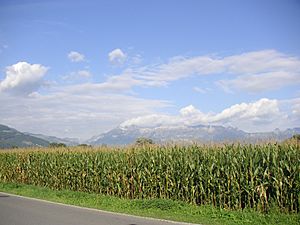
Maize began to spread widely and quickly around 2500 BC. It was first grown in the United States, in New Mexico and Arizona, around 2100 BC. As it was introduced to new cultures, people found new ways to use it. They also chose new types that worked better for their needs. Maize was a main food for most pre-Columbian cultures in North America, Mesoamerica, South America, and the Caribbean. It was often eaten with squash, potatoes, quinoa, beans, and amaranth. Maize was very important to the Mesoamerican people. It shaped their identity through farming, its spiritual meaning, and its role in their diet. During the first 1,000 years AD, maize farming spread from Mexico to the U.S. Southwest. In the next 1,000 years, it spread to the U.S. Northeast and southeastern Canada. This changed the land as Native Americans cleared large areas for the new crop.
It is not known why maize was first domesticated. The wild version's edible part is very small and hard to get. Each kernel is inside a very hard shell. However, George Beadle showed that teosinte kernels can be easily "popped" and eaten, like modern popcorn. Some people thought it would take too many generations of selective breeding to make large, compact ears. But studies of hybrids made by crossing teosinte and modern maize suggest this is not true.
In 2005, research showed that more maize farming 500 to 1,000 years ago in the southeastern United States led to a drop in freshwater mussels. Mussels are very sensitive to changes in their environment.
Growing Maize
Farming Methods
Maize does not like cold weather. So, in places with moderate climates, it must be planted in the spring. Its root system is usually shallow. This means the plant needs enough moisture in the soil. Maize is a C4 plant, which means it uses water more efficiently than C3 plants like wheat or soybeans. Maize is most sensitive to dry weather when its silks appear. This is when the flowers are ready for pollination. In the United States, a good harvest was traditionally expected if the maize was "knee-high by the Fourth of July." But modern types of maize usually grow faster than this. Maize grown for silage is harvested while the plant is green and the fruit is not yet ripe. Sweet corn is harvested when it is in the "milk stage." This is after pollination but before starch has formed, usually in late summer to mid-autumn. Field maize is left in the field very late in the autumn to dry the grain completely. Sometimes it is not harvested until winter or early spring. The need for enough soil moisture is clear in many parts of Africa. There, dry periods often cause maize crop failure and famine. Even though it mainly grows in wet, hot climates, maize can grow in cold, hot, dry, or wet conditions. This means it is a very adaptable crop.
Native Americans planted maize in hills. This was part of a complex system known as the Three Sisters. Maize stalks supported beans. The beans added nitrogen to the soil from bacteria on their roots. Squash plants covered the ground. This stopped weeds and kept the soil moist by providing shade. This method was later replaced by planting single species in hills. Each hill was 2 to 4 feet apart and had three or four seeds. Home gardeners still use this method. A later technique was "checked maize." Hills were placed 40 inches apart in every direction. This allowed farmers to use tools to cultivate the field in two directions. In drier areas, seeds were planted in the bottom of 4 to 5 inch deep furrows to collect water. Modern farming plants maize in rows. This allows for cultivation when the plant is young. However, the hill technique is still used on some Native American reservations.
In North America, fields are often planted in a two-crop rotation. One crop is often a nitrogen-fixing crop, like alfalfa in cooler places or soybeans in warmer areas. Sometimes, winter wheat is added to the rotation.
Many maize types grown in the United States and Canada are hybrids. Often, these types have been genetically modified to handle glyphosate. Glyphosate is an herbicide that kills most plants, but not those with this special genetic trait. This trait is very rare in nature. Other types are modified to protect against natural pests.
In the midwestern United States, farmers often use low-till or no-till farming methods. In low-till farming, fields are tilled once or twice before planting or after the last harvest. Then, the fields are planted and fertilized. Weeds are controlled with herbicides, and no tilling is done while the crop grows. This method helps keep moisture in the soil, giving more water to the crop. These methods help farmers grow crops without disturbing the soil much. Weeds compete with the crop for water and nutrients, so they are not wanted.
Before World War II, most maize in North America was harvested by hand. This needed many workers and often involved social events. Some mechanical pickers were used, but the maize combine became common after the war. When harvested by hand or with a mechanical picker, the whole ear is picked. Then, a separate machine removes the kernels from the ear. Whole ears of maize were often stored in corn cribs. These whole ears could be used to feed some livestock. Few modern farms store maize this way. Most harvest the grain from the field and store it in bins. A combine with a maize head pulls the stalk down. The stalk is crumpled on the ground. The ear of maize is too big to pass through slots as the stalk is pulled away. This leaves only the ear and husk to enter the machine. The combine separates the husk and cob, keeping only the kernels.
How Much Maize Is Grown?
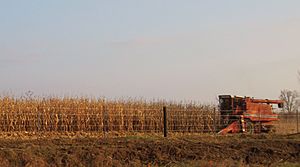
Maize is grown all over the world. More maize is produced each year than any other grain. The United States grows 40% of the world's maize. Other top producing countries include China, Brazil, Mexico, Indonesia, India, France, and Argentina. In 2009, the world produced 817 million tonnes of maize. This was more than rice (678 million tonnes) or wheat (682 million tonnes). In 2009, over 159 million hectares (390 million acres) of maize were planted worldwide. The yield was over 5 tonnes per hectare (80 bushels per acre). Production can be much higher in some parts of the world. For example, in 2009, Iowa was expected to produce 11614 kg per hectare (185 bushels per acre).
There are different ideas about whether maize yield potential has increased over the last few decades. This suggests that changes in yield are linked to things like leaf angle, how well the plant stands up, how well it grows in dense plantings, and disease resistance. It is not mainly due to an increase in yield per individual plant.
| Top ten maize producers in 2009 | ||||
|---|---|---|---|---|
| Country | Production (tonnes) | Note | ||
| 333,010,910 | ||||
| 163,118,097 | ||||
| 51,232,447 | ||||
| 20,202,600 | ||||
| 17,629,740 | ||||
| 17,300,000 | ||||
| 15,299,900 | ||||
| 13,121,380 | ||||
| 12,050,000 | ||||
| 10,486,300 | ||||
| World | 817,110,509 | [A] | ||
| No symbol = official figure, A = Aggregate (may include official, semiofficial or estimates). | ||||
Maize in the United States
In 2010, the area planted with maize in the U.S. was about 35 million hectares (87.9 million acres). This has been increasing since 2008. About 14% of the harvested corn area is watered using irrigation.
In 2011, corn production went down about 1% to about 12.5 billion bushels. The average yield was about 148.1 bushels per acre. This made 2011 the year with the lowest average yield since 2005.
Maize Pests
Insect Pests
Many insects can harm maize crops:
- Corn earworm
- Fall armyworm
- Common armyworm
- Stalk borer
- Corn leaf aphid
- European corn borer (ECB)
- Corn silkfly
- Lesser cornstalk borer
- Corn delphacid
- Western corn rootworm
- Southwestern corn borer
- Maize weevil
Maize is easily damaged by the European corn borer. This causes big crop losses. Because of this, scientists developed "Bt maize." This is a genetically modified plant that makes a toxin from the Bacillus thuringiensis bacteria. This toxin protects the maize from the borer. "Bt maize" is widely grown in the United States and is allowed in Europe.
Ways We Use Maize
Maize as Human Food
Maize and cornmeal (dried ground maize) are main foods in many parts of the world. The Portuguese brought maize to Africa in the 16th century. Since then, it has become Africa's most important main food crop. Cornmeal is made into a thick porridge in many cultures. Examples include polenta in Italy, angu in Brazil, and mămăligă in Romania. In the U.S., it is called cornmeal mush or grits. In South Africa, it is called mealie pap, and in other parts of Africa, sadza, nshima, and ugali. Cornmeal is also used instead of wheat flour to make cornbread and other baked goods. Masa (cornmeal treated with lime water) is the main ingredient for tortillas, atole, and many other Mexican dishes.
Popcorn is made from special kernels that explode when heated. They form fluffy pieces eaten as a snack. Roasted dried maize ears with semi-hard kernels are a popular snack food in Vietnam. They are coated with fried chopped spring onions and salt. Cancha, which are roasted maize chulpe kernels, are a very popular snack in Peru. They are also used in traditional Peruvian ceviche. An unleavened bread called makki di roti is popular in the Punjab region of India and Pakistan.
Chicha and chicha morada (purple chicha) are drinks made from specific types of maize. The first one is fermented and alcoholic. The second is a soft drink commonly enjoyed in Peru. Corn flakes are a common breakfast cereal in North America and the United Kingdom. They are also found in many other countries.
Maize can also be prepared as hominy. For this, the kernels are soaked in lye in a process called nixtamalization. Or it can be made into grits, which are coarsely ground hominy. These are commonly eaten in the Southeastern United States. These foods were passed down from Native Americans, who called the dish sagamite.
The Brazilian dessert canjica is made by boiling maize kernels in sweetened milk. Maize can also be harvested and eaten when it is unripe. At this stage, the kernels are fully grown but still soft. Unripe maize usually needs to be cooked to taste good. This can be done by boiling or roasting the whole ears and eating the kernels right off the cob. Sweet corn is a type of maize that has a lot of sugar and little starch. It is usually eaten unripe. Such corn on the cob is a common dish in the United States, Canada, the United Kingdom, Cyprus, parts of South America, and the Balkans. But it is almost unknown in some European countries. Corn on the cob was sold on the streets of early 19th-century New York City by "Hot Corn Girls." These girls were like the first hot dog carts or fruit stands seen in big cities today. The cooked, unripe kernels can also be cut off the cob and served as a vegetable in side dishes, salads, or as a garnish. Also, raw unripe kernels can be grated off the cobs and made into many cooked dishes. These include maize purée, tamales, pamonhas, curau, cakes, and ice creams.
| Nutritional value per 100 g (3.5 oz) | |
|---|---|
| Energy | 360 kJ (86 kcal) |
|
19.02 g
|
|
| Sugars | 3.22 g |
| Dietary fiber | 2.7 g |
|
1.18 g
|
|
|
Protein
|
3.22 g
|
| Tryptophan | 0.023 g |
| Threonine | 0.129 g |
| Isoleucine | 0.129 g |
| Leucine | 0.348 g |
| Lysine | 0.137 g |
| Methionine | 0.067 g |
| Cystine | 0.026 g |
| Phenylalanine | 0.150 g |
| Tyrosine | 0.123 g |
| Valine | 0.185 g |
| Arginine | 0.131 g |
| Histidine | 0.089 g |
| Alanine | 0.295 g |
| Aspartic acid | 0.244 g |
| Glutamic acid | 0.636 g |
| Glycine | 0.127 g |
| Proline | 0.292 g |
| Serine | 0.153 g |
| Vitamins | Quantity
%DV†
|
| Vitamin A equiv.
lutein zeaxanthin
|
1%
9 μg
644 μg
|
| Thiamine (B1) |
17%
0.200 mg |
| Niacin (B3) |
11%
1.700 mg |
| Vitamin B6 |
7%
0.093 mg |
| Folate (B9) |
12%
46 μg |
| Vitamin C |
8%
6.8 mg |
| Minerals | Quantity
%DV†
|
| Iron |
4%
0.52 mg |
| Magnesium |
10%
37 mg |
| Potassium |
9%
270 mg |
| Other constituents | Quantity |
| Water | 75.96 g |
|
One ear of medium size (6-3/4" to 7-1/2" long)
maize has 90 grams of seeds |
|
| †Percentages estimated using US recommendations for adults. | |
Maize is a main source of starch. Cornstarch (maize flour) is a key ingredient in home cooking and many factory-made food products. Maize is also a main source of cooking oil (corn oil) and maize gluten. Maize starch can be treated to make syrups, especially high fructose corn syrup, which is a sweetener. It can also be fermented and distilled to make grain alcohol. Grain alcohol from maize is traditionally used to make Bourbon whiskey. Maize is sometimes used as the starch source for beer.
In the United States, only about 1/40th of the maize grown is used for human food. In the United States and Canada, most maize is grown to feed livestock. It is used as forage, silage (made by fermenting chopped green cornstalks), or grain. Cornmeal is also a big part of some commercial animal foods, like dog food.
Maize is also used as fish bait, called "dough balls." It is very popular in Europe for coarse fishing.
Maize in Medicine
The silks from female maize flowers, called corn silk, are sold as herbal supplements.
Maize in Chemicals
Starch from maize can also be made into plastics, fabrics, adhesives, and many other chemical products.
The corn steep liquor is a watery byproduct from processing maize. It is widely used in the biochemical industry and research. It serves as a culture medium to grow many kinds of microorganisms.
Maize as Biofuel
"Feed maize" is being used more and more for heating. Special corn stoves (like wood stoves) are available. They use either feed maize or wood pellets to create heat. Maize cobs are also used as a biomass fuel source. Maize is relatively cheap, and furnaces have been made that use maize kernels as fuel. They have a large container that feeds the uniformly sized maize kernels (or wood pellets or cherry pits) into the fire.
Maize is increasingly used to make ethanol fuel. Ethanol is mixed with gasoline to reduce pollutants from motor vehicles. High fuel prices in mid-2007 led to more demand for ethanol. This, in turn, led to higher prices for farmers selling maize. This made the 2007 harvest one of the most profitable maize crops in modern history for farmers. Because fuel and maize are linked, the price of maize now often follows the price of oil.
The price of food is somewhat affected by using maize for biofuel. The costs of transportation, production, and marketing make up a large part (80%) of food prices in the United States. Higher energy costs affect these costs, especially transportation. The increase in food prices consumers have seen is mainly due to higher energy costs. The effect of biofuel production on other food crop prices is indirect. Using maize for biofuel increases its demand and price. This then causes farmland to be used for maize instead of other food crops. This reduces the supply of other food crops and increases their prices.
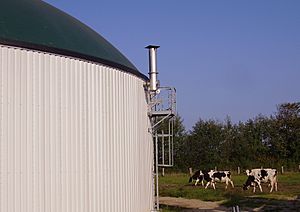
Maize is widely used in Germany to feed biogas plants. Here, the maize is harvested, shredded, and then stored in silage clamps. From there, it is fed into the biogas plants. This process uses the whole plant, not just the kernels, as in making fuel ethanol.
A biomass gasification power plant in Strem, Austria, started in 2005. Research is being done to make diesel from biogas using the Fischer Tropsch method.
More and more, ethanol is used in small amounts (10% or less) as an additive in gasoline (gasohol) for motor fuels. This helps increase the octane rating, lower pollutants, and reduce the use of petroleum.
Other Uses for Maize
Some types of maize plants are grown in gardens just for their beauty. For this, people use plants with colorful leaves or ears. Very tall types, reaching 40 feet, or cobs 2 feet long, or 1-inch kernels, have been popular for at least a century.
Corncobs can be hollowed out and treated to make cheap smoking pipes. These were first made in the United States in 1869.
An unusual use for maize is to create a "corn maze" (or "maize maze") as a fun place for tourists. The idea of a maize maze was started by Adrian Fisher and The American Maze Company in Pennsylvania in 1993. Traditional mazes are often made from yew hedges, but these take many years to grow. Maize grows quickly. A maze can be planned using GPS at the start of a growing season. The maize then grows tall enough to block a visitor's view by summer. In Canada and the U.S., these are popular in many farming towns.
Maize kernels can be used instead of sand in a sandbox-like area for children to play.
Also, feed corn is sometimes used by hunters to attract animals like deer or wild hogs.
Maize as Fodder
Maize produces more plant material above ground than other cereal plants. So, it can be used for fodder (animal feed). It is easier for animals to digest and tastes better when it is ensiled and fermented, rather than just dried.
Maize as a Commodity
Maize is bought and sold by investors and traders as a product using corn futures contracts. These "futures" are traded on the Chicago Board of Trade (CBOT) under the symbol C. They are delivered every year in March, May, July, September, and December.
Images for kids
-
Ancient Mesoamerican relief, National Museum of Anthropology of Mexico
-
Multicolored corn kernels (CSIRO)
-
Teosinte (top), maize-teosinte hybrid (middle), maize (bottom)
-
Stucco head of the Maya maize god, 550–850 AD
-
Harvesting maize, Rantasalmi, South Savonia, Finland
-
Mexican tamales made with corn meal
See Also
 In Spanish: Maíz para niños
In Spanish: Maíz para niños



